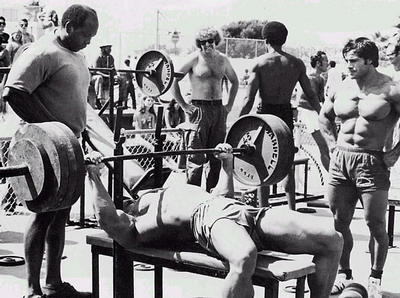How to Bench Press
Update: I found a sweet How to Bench Press video by elite powerlifter Dave Tate today. The video appears about halfway through this post. If you want to bench press for max strength and “think” you have perfect form, you NEED to watch this video. Therefore I am republishing this article today for every Swole Bench Presser’s benefit.

I get plenty of questions in various comments throughout the website, but I also get comments and questions via the Project Swole Contact Form.
Generally, I address those questions through e-mail, but often I do not have the time to reply to each and every question personally.
From now on I want to take a more proactive approach to answer Your Health Questions by posting them separately in the blog. This way we can be sure that everyone benefits from the Q & A.
Kyle wrote:
“Hey Steve, OK me and a friend got into an argument about how to bench. I said you should touch your chest and he said you shouldn’t because it can injure your shoulder you should stop like 1 inch away from your chest? What is the right way to bench?”
Response:
So, you want to know how to bench press properly?

The bench press is the most popular exercise in the gym among men. It is the strongest upper body exercise for most people and has been a social gauge (and wrongly so, in my opinion) of male strength and fitness for more than a century. Fortunately, bench presses are the #1 best exercise for building upper body strength and size, and so should be included in nearly all strength training routines.
On the downside, benching is responsible for many weight lifting injuries, especially in the shoulder area. Hopefully, this post will educate you as to how you should be bench pressing to avoid injury.
How to Bench Press
A concept of a bench press is simple:
Start by laying down on a bench. Place your hands on the barbell with your palms facing away from you (this is a pronated grip). Unrack the barbell and hold it straight up over your upper chest. Bend at the elbows to lower the barbell until it touches your mid-chest. Press it back up over your upper chest. That’s a rep.
In reality, using proper form on the bench press can be difficult to master, as you will see when you read this post in its entirety.
Now, to answer your questions…
How to Bench with Proper Form
Let me start by saying that I believe in lowering the weight to my chest. I prefer to touch-and-go with most exercises, and I’ve never experienced any negative repercussions using that protocol. Using touch-and-go is the only way to be sure you are lowering the weight to the same spot each time.
When you use proper form, there is no reason for you to feel discomfort in your shoulders.
If benching is causing you shoulder issues it is likely due to at least one of the following possible reasons:
- You have weak rotator cuff muscles. To fix this, read about how to avoid rotator cuff injury.
- You are benching too wide. Extreme wide grip bench pressing is not advised if you want to save your shoulders.
To find the right grip for proper bench pressing form, follow these tips for proper arm placement:
- Lay down on a bench (or stand up if you want).
- Put your arms in the bench press position with elbows bent at a 90-degree angle between forearms and biceps, and another 90-degree angle at the armpits, between the upper arms and the back. This is how NOT to bench press.
- Now decrease the armpit angle to only 45 degrees. This will increase the tension on the triceps and decrease the tension on the shoulders. Over time your shoulders will experience less strain and your triceps will get much stronger.
- Grasp the bar with your hands directly over your elbows, with thumbs 2-3 inches outside of the shoulders.
- Elbows should stay under the hands through the descent and should flare out when pressing the bar through the lockout.
Although you will keep your elbows in at a 45-degree angle, this is not a close grip bench by any means.
- The path from the top of the press to your chest is too long. You want the shortest path possible from the bottom to the top of the rep in order to save energy.
As you lay on the bench to begin your set, be sure to use these tips for proper bench posture:
- Puff your chest out by elevating your rib cage like you are about to strut your stuff in front of the super-sexy girl next door.
- Retract your shoulder blades by pulling your shoulders and elbows back.
- Push your traps and upper back into the bench while keeping those shoulder blades back and in.
- Only your head, upper back, and buttocks should actually be touching the bench, but you should NOT have an exaggerated curve in your lower spine (the lumbar curve).
- Finally, attempt to flare or flex the lats. This will give you a wider surface area on the bench and will help when pushing the weight out of the hole. That is why elite powerlifters will tell you that you need a big back to have a big bench.
- You set up too far away from the bar. When you unrack the bar, it should be nearly in pressing position. Lay down so that your shoulders are only an inch or two forward of the unracked bar. Pull the bar forward off the rack rather than lifting it up and over.
- You are not using your feet properly. For maximum strength and stability, you want your feet to stay planted on the floor directly underneath your legs at all times. Your feet should not jump around during the set, and in fact, you should drive through your heels to generate additional force when pressing.
This does NOT mean that your butt should leave the bench at any time during your lift, or that you should exaggerate that lumbar curve we were talking about earlier.
- You are not using your triceps properly. Once the bar passes the half-way point in a rep, you want to try to break the bar in half, which activates the triceps to assist in locking the bar out at the top.
How to Bench Press For Maximum Strength
The following video by elite powerlifter Dave Tate, will teach you exactly how to bench press like a powerlifter. If you want to lift for max strength, healthy shoulders, and don’t much care about anything else, use every tip in this video.
https://www.youtube.com/watch?v=Dh3t6T-nqP0&feature=player_embeddedBench Press Variations
Here are some common variations on the bench press:
- Close Grip Bench Press – Use a shoulder-width grip to put more emphasis on the triceps.
- Incline Bench Press – Use an incline to put more emphasis on the upper chest and shoulders.
- Decline Bench Press – Use a decline to put more emphasis on the lower chest and triceps. Usually allows the lifter to use more weight than a standard bench press.
- Floor Press – Lying on the floor to bench cuts the range of motion in half, and puts more emphasis on the triceps.
- Board Press – Similar to floor press, but use a board on top of the chest to limit the range of motion rather than lying on the floor.
- Pin Press – Use a rack with adjustable pins to bench using any range of motion. Useful for training specific sticking points.
- Band Press – Use mini-bands to train force output and acceleration by adding resistance as you push up.
Common Bench Press Mistakes
Here is a list of what you and many others are probably doing wrong when you bench press. Fix these issues and experience more success!
- Using a Thumbless Grip – Wrap your thumbs around the bar when bench pressing. Do not tuck them in beside your index finger and bench with an open palm.
- Using Too Much Weight – Add weight gradually or you risk injuring your shoulder, rotator cuff, or tearing a pec. Those injuries take upwards of 6 months to recover.
- Benching Heavy Without a Spotter – When maxing or pushing a set to the limit, you want someone available to take the bar off your chest or neck if you hit failure. If that’s not an option, you should read about how to bench press safely without a spotter.
- Using the Smith Machine – All smith machines belong in a junkyard. The smith limits your motion to a single plane and can encourage a wide variety of injuries stemming from muscular imbalances and weakness in the stabilizers.
- Not Training Your Back – You should train your back as hard and as often as you train your chest. Anything less will create muscle imbalance between the chest and back, and between the front and rear delts. This will ruin your posture thereby making you look like a hunchback and encouraging injury. Use these top 5 best back exercises.
- Lifting Your Butt off the Bench – Keep it down to avoid back injury.
- Bouncing – Do not bounce the bar off your chest. Simply touch and go. Do not bounce your feet on the floor. Keep them in one spot.
- Hands are too Wide – Keep them within a couple of inches of shoulder width.
- Elbows are too Wide – Keep a 30-45 degree angle at the armpit.
I have mentioned the answers to some common questions and highlighted common mistakes several times throughout this post. That must mean they are important. Using these tips will help you to become a better bench presser, and will help you to avoid bench press related injuries.
Tags: bench press, benching, chest, chest training, Conditioning, technique, weightlifting











Thanks for the post. And I also want to add how to do the chest press with the band.
Step 1
Lay your thighs on the ground and place a resistance band underneath your shoulders and hold both handles.
Step 2
Keep your upper arms in contact with the floor.
Step 3
Pull the band up with your arms, making sure you extend both of your arms until they’re straight.
Step 4
Lower them back to starting position and repeat.
I am a huge fan of close grip benches. I think its one of the best exercises for tris (I also like French curls). I teach high school and I was showing some kids how to bench. They are amazed at how when they did it properly even though it felt awkward they all said that they could “feel” how it is more powerful. GREAT SITE by the way THANKS!
Close grip bench is one of my favorites. I remember for a while in college I could close grip bench more than I could with medium grip. Love it!
I have been following your advise and tips on how to become a better bench pressrr and so far it has worked for me , thank you very much.
dude your so old it doesn't even matter
Carl Thompson What is your problem, man? Can't wait till you get "so old" and someone makes a comment about your age, jerk.
Gain Weight Guide…
How to Bench Press | Project Swole…
Nice article, i Like close-grip a lot as well !
I am 14. 220 lbs and trying to get stonger for football. However i can only bench around 95lbs. How do i improve that?
How long have yoyu been lifting ? Try to shoot around 8 reps, work your way up as long as you can’t lift 8 reps no more. Do heavy triceps and shoulder work, not more than 6-8 reps as well. Switch exercise every 5 weeks. Go 4 seconds on the excentric level and explosiv on the way up
How to Bench Press…
Just in case you all need some help. =)…
I have a question. Im only 5’3″ tall so I struggle to use my legs like I should during the bench press. I can only get my toes onto the ground. I weigh 120lbs and im currently benching 175 for 6. But I feel that if I could use my legs a little that would increase. Do you have any ideas?
I put boards or 25-45 pound plates on the floor beside the bench so that my feet will reach the ground properly. Some people will look at you funny, but that’s only because they don’t know how to bench properly – they would probably put their feet on the bottom of the bench or something.
Steve – great site – thank you.
One question – since breaking my wrist (some years ago) I can’t comfortably do a bench press with my thumb wrapping the bar, so I do them “open palm”. I comfortably bench 3×6 at 80% of bodyweight in doing so. That said, is breaking the “wrap the thumb rule” that bad?
Cheers,
J
Steve,
I use a Smith machine when performing four exercises in total. A squat, standing calf raise, incline bench, and normal bench. The reason I do this is because I generally do not have a spotter as I work out after 9 PM every night and everyone at the gym is either too light or I am alone. I feel more safe using this machine to perform these exercises but if you have a suggestion besides lowering the weight so I can do these without the Smith Machine than I can attempt this at least. Thanks in advance for any feedback.
Sometimes, I will completely lift my legs off the floor, and flatten my back fully on the bench while I squeeze out a set. To me, this feels like i’m completely isolating my upper body. Should I continue to do this? I always use a lower weight when performing the bench this way, and so far I’ve experienced no injuries. I’ve been doing these sets for about 4 months now
Some people do it that way. As long as you are comfortable lifting less weight then I guess you can do it that way. Let me ask you a question: why would you want to completely isolate your upper body? Wouldn’t you prefer to use every means possible, short of cheating and jeopardizing your form, to allow your body to lift the most weight, so that you can experience the best strength and muscle gains? Just wondering.
Steve
Thank you for this article! I am doing the bench press wrong but I won’t anymore!
One question though the video says it has been removed, can you recommend another?
Actually, I think the only use for the smith machine is the standing barbell calf raises. It works good.
Nice point! You are so right, that is a great exercise.